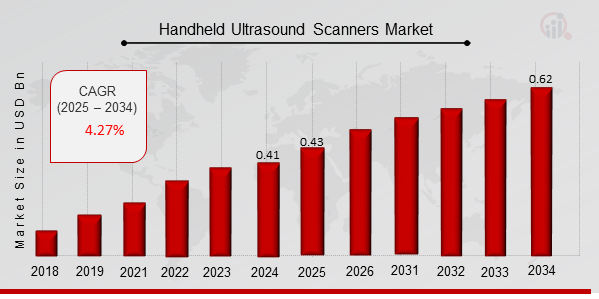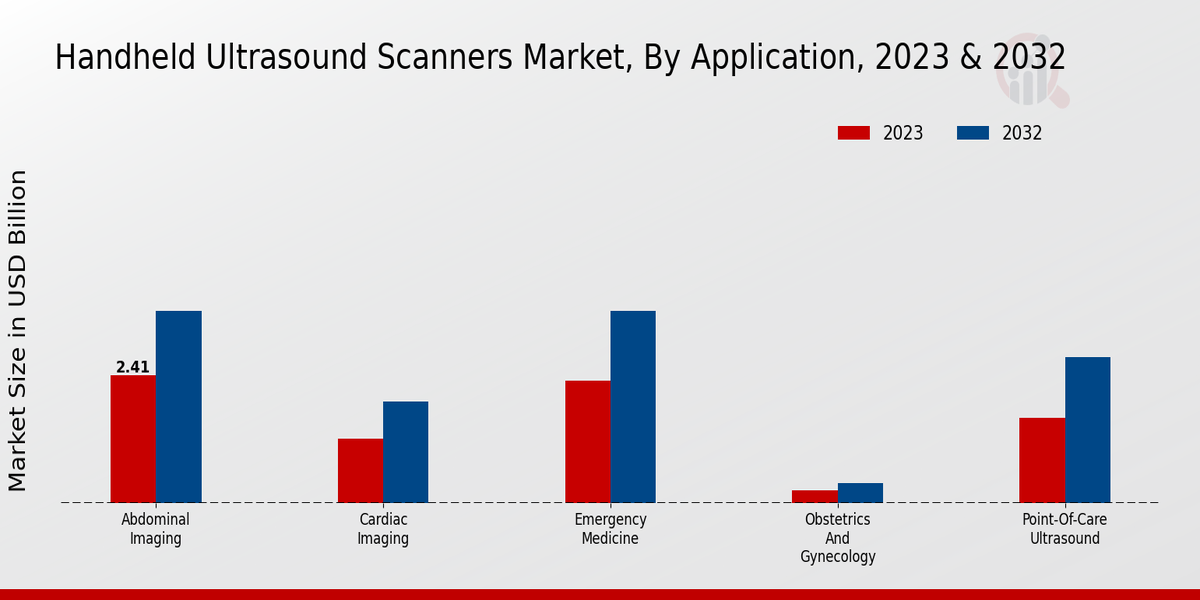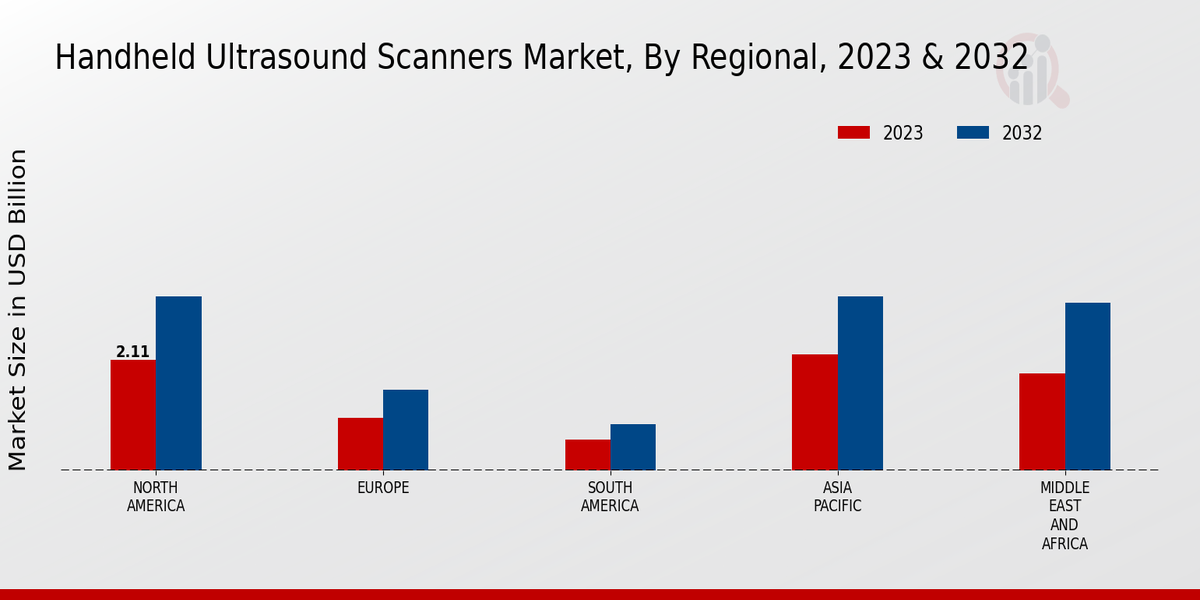Global Handheld Ultrasound Scanners Market Overview
As per MRFR analysis, the Handheld Ultrasound Scanners Market Size was estimated at 0.41 (USD Billion) in 2024. The Handheld Ultrasound Scanners Market Industry is expected to grow from 0.43 (USD Billion) in 2025 to 0.62 (USD Billion) till 2034, at a CAGR (growth rate) is expected to be around 4.27% during the forecast period (2025 - 2034).
Key Handheld Ultrasound Scanners Market Trends Highlighted
The Handheld Ultrasound Scanners Market is experiencing significant growth due to advancements in technology, increased demand for point-of-care diagnostics, and a shift towards personalized medicine.
The market is driven by factors such as the rising prevalence of chronic diseases, an aging population, and the growing adoption of minimally invasive procedures.
Key market drivers include the increasing use of handheld ultrasound scanners in emergency medicine, critical care, and primary care settings. The growing demand for portable and affordable devices for quick and reliable diagnostics is also fueling market expansion.
Additionally, the integration of advanced imaging capabilities, such as 3D and 4D ultrasound, is enhancing the accuracy and versatility of handheld scanners.
Recent market trends include the emergence of wireless and app-based ultrasound scanners, which offer greater mobility and convenience. The development of AI algorithms for image processing and interpretation is also enhancing the diagnostic capabilities of handheld ultrasound scanners.
Furthermore, the growing adoption of telemedicine platforms is creating new opportunities for remote patient monitoring and diagnosis using handheld ultrasound devices.

Source: Primary Research, Secondary Research, MRFR Database and Analyst Review
Handheld Ultrasound Scanners Market Drivers
Rising Prevalence of Chronic Diseases
The increasing prevalence of chronic diseases such as cardiovascular ailments, diabetes, and cancer is a primary driver of the Handheld Ultrasound Scanners Market Industry.
The ability of handheld ultrasound scanners to provide real-time, non-invasive imaging for the diagnosis and monitoring of these conditions makes them an indispensable tool for healthcare professionals.
As the burden of chronic diseases continues to rise globally, the demand for handheld ultrasound scanners is expected to grow substantially in the coming years.
Technological Advancements and Innovation
Rapid advancements in technology are fueling the growth of the Handheld Ultrasound Scanners Market Industry.
The introduction of features such as wireless connectivity, artificial intelligence algorithms, and miniaturization has significantly enhanced the capabilities and ease of use of handheld ultrasound scanners.
The increasing adoption of these advanced technologies is expected to drive market growth in the years ahead.
Expanding Applications in Point-of-Care Settings
The growing adoption of point-of-care ultrasound (POCUS) is a key factor contributing to the growth of the Handheld Ultrasound Scanners Market Industry.
Handheld ultrasound scanners are increasingly being used in emergency departments, clinics, and remote settings, where immediate access to imaging is crucial.
The ability of these devices to provide rapid and accurate diagnostic information at the point of care is driving their adoption in a wide range of clinical settings.
Handheld Ultrasound Scanners Market Segment Insights
Handheld Ultrasound Scanners Application Insights
The Handheld Ultrasound Scanners Market is segmented based on applications into Abdominal Imaging, Cardiac Imaging, Emergency Medicine, Obstetrics, Gynecology, and Point-of-Care Ultrasound.
The Abdominal Imaging segment held the largest market share in 2023 and is expected to maintain its dominance over the forecast period. The growth of this segment is attributable to the increasing demand for handheld ultrasound scanners in several abdominal imaging applications including liver, gallbladder, kidney, and other related procedures.
The Cardiac Imaging segment is expected to register a considerable CAGR over the forecast period, owing to the rising prevalence of cardiovascular diseases across the globe, the increasing interest to use handheld ultrasound scanners for cardiac imaging diagnosis, such as echocardiography and stress echocardiography.
The Emergency Medicine segment is also likely to exhibit notable growth, due to the surge in the demand for ultrasound scanners to understand the status of trauma and other related emergencies.
The Obstetrics and Gynecology segment is expected to grow at a steady rate over the forecast period, which is owing to the rise in the demand for these scanners for prenatal care and gynecological examinations.
The Point-of-Care Ultrasound segment is estimated to register a notable CAGR as the use of handheld ultrasound scanners is increasing for various point-of-care applications such as wound care, vascular access, and musculoskeletal purposes.
Overall, the Handheld Ultrasound Scanners Market is expected to expand at a considerable rate over the forecast period due to the growing demand for ultrasound scanners in several applications.

Source: Primary Research, Secondary Research, MRFR Database and Analyst Review
Handheld Ultrasound Scanners Technology Insights
The technology segment is segmented into Convex Array, Linear Array, Phased Array, and Sector Array. Convex Array technology holds the largest market share due to its wide field of view and ability to penetrate deeper into the body. Linear Array technology is preferred for superficial imaging applications, such as vascular imaging and musculoskeletal imaging.
Phased Array technology offers high-quality images with reduced artifacts, making it suitable for cardiac imaging and abdominal imaging. Sector Array technology is commonly used in echocardiography and provides a wide field of view with good penetration depth.
The increasing adoption of handheld ultrasound scanners in various clinical settings, such as point-of-care, emergency medicine, and remote patient monitoring, is driving the growth of the technology segment.
Handheld Ultrasound Scanners Portability Insights
The increasing demand for point-of-care diagnostics, technological advancements, and the growing prevalence of chronic diseases are key factors driving the growth of the handheld ultrasound scanners market.
Portability is a crucial factor in the market, with different types of handheld ultrasound scanners available catering to specific needs. Portable ultrasound scanners are designed for maximum portability and ease of use.
They are lightweight, compact, and can be easily carried around by healthcare professionals. Portable scanners are often used in emergency settings, remote locations, or for quick bedside examinations.
The global market for portable handheld ultrasound scanners is expected to grow significantly in the coming years due to their increasing adoption in various clinical settings. Semi-portable ultrasound scanners offer a balance between portability and functionality.
They are larger and heavier than portable scanners but provide more advanced imaging capabilities. Semi-portable scanners are often used in clinics, small hospitals, and other healthcare facilities where space is a constraint.
The market for semi-portable handheld ultrasound scanners is expected to grow steadily over the forecast period.
Cart-based ultrasound scanners are the largest and most advanced type of handheld ultrasound scanners. They are mounted on a cart, which provides stability and allows for easier maneuverability. Cart-based scanners offer the highest image quality and are often used in larger hospitals and medical centers.
The market for cart-based handheld ultrasound scanners is expected to grow at a moderate pace in the coming years.
Handheld Ultrasound Scanners Frequency Range Insights
The Handheld Ultrasound Scanners Market segmentation by frequency range offers valuable insights into the diverse applications of these devices. The low-frequency segment (2-5 MHz) caters to superficial imaging needs, making it suitable for examinations of organs located near the body's surface, such as the thyroid, breast, and abdomen.
Its affordability and ease of use contribute to its widespread adoption in primary care settings. The mid-frequency segment (5-12 MHz) strikes a balance between penetration depth and resolution, making it ideal for abdominal and pelvic scans.
Its ability to visualize deeper structures, including the liver, kidneys, and reproductive organs, has led to its popularity in hospital settings. The high-frequency segment (12-20 MHz) excels in providing detailed images of superficial structures, such as muscles, tendons, and small blood vessels.
Its higher resolution enables precise evaluation of musculoskeletal conditions and is commonly used in orthopedic and rheumatology practices. In 2023, the Handheld Ultrasound Scanners Market revenue for the low-frequency segment was estimated at $2.5 billion, while the mid-frequency segment held a dominant share of $3.2 billion.
The high-frequency segment is projected to witness significant growth, reaching a projected value of $1.8 billion by 2032, driven by advancements in technology and increasing demand for specialized imaging applications.
Handheld Ultrasound Scanners End-Use Setting Insights
The End-Use Setting segment is a key factor in driving the growth of the Handheld Ultrasound Scanners Market. In 2023, the market was valued at 7.78 USD Billion, and it is expected to reach 12.29 USD Billion by 2032, exhibiting a CAGR of 4.27%.
The increasing adoption of handheld ultrasound scanners in various end-use settings, such as hospitals, clinics, diagnostic imaging centers, ambulatory surgery centers, and home healthcare, is contributing to the market's growth.
Hospitals account for the largest share of the market due to the high volume of patients requiring diagnostic imaging services.
Clinics and diagnostic imaging centers are also significant contributors to the market's growth, as they offer convenient and cost-effective diagnostic services to patients.
Ambulatory surgery centers are gaining popularity due to the increasing demand for minimally invasive procedures, which require the use of handheld ultrasound scanners for real-time imaging.
Home healthcare is another growing segment of the market, as handheld ultrasound scanners enable healthcare professionals to provide diagnostic services in the comfort of patients' homes.
Handheld Ultrasound Scanners Regional Insights
The Handheld Ultrasound Scanners Market is segmented into North America, Europe, APAC, South America, and MEA.
North America is the largest regional market, accounting for over 40% of the global revenue in 2023. Europe is the second-largest regional market, with a market share of around 30%.
APAC is the fastest-growing regional market, with a CAGR of over 7%. The growth in APAC is attributed to the increasing demand for handheld ultrasound scanners in emerging economies such as China and India.
South America and MEA are relatively smaller regional markets, but they are expected to grow at a healthy pace in the coming years.
The growth in these regions is driven by the increasing adoption of handheld ultrasound scanners in rural and remote areas.

Source: Primary Research, Secondary Research, MRFR Database and Analyst Review
Handheld Ultrasound Scanners Market Key Players and Competitive Insights
Major players in the Handheld Ultrasound Scanners Market industry are continuously focusing on the development of innovative and advanced technologies to gain a competitive edge in the market. Leading Handheld Ultrasound Scanners Market players are investing in research and development activities to enhance the functionality and accuracy of their devices.
Moreover, strategic collaborations and partnerships among key players are also shaping the competitive landscape of the Handheld Ultrasound Scanners Market.
SonoSite, Inc. is one of the leading players in the Handheld Ultrasound Scanners Market. The company offers a comprehensive range of handheld ultrasound devices designed for various clinical applications, including emergency medicine, critical care, and point-of-care settings.
SonoSite's focus on innovation and customer satisfaction has contributed to its strong position in the market. The company's devices are known for their compact size, portability, and ease of use, making them ideal for use in resource-constrained environments and for quick and effective point-of-care diagnostics.
GE Healthcare is another prominent player in the Handheld Ultrasound Scanners Market. The company's handheld ultrasound solutions are designed to meet the diverse needs of healthcare professionals across various specialties.
GE Healthcare's handheld ultrasound devices are known for their high-quality imaging capabilities, advanced features, and user-friendly design.
The company's strong brand reputation and global presence have enabled it to establish a significant market share in the Handheld Ultrasound Scanners Market. GE Healthcare continues to invest in research and development to enhance its product portfolio and maintain its competitive position in the market.
Key Companies in the Handheld Ultrasound Scanners Market Include:
- Samsung Electronics
- Medison
- Koninklijke Philips
- Nexus
- FUJIFILM SonoSite
- Siemens Healthineers
- Esaote
- Terason
- Mindray
- Clarius Mobile Health
- GE Healthcare
- Zonare
- Lumify
- Hitachi
- Butterfly Network
Handheld Ultrasound Scanners Market Industry Developments
The rising prevalence of chronic diseases, increasing demand for point-of-care diagnostics, and technological advancements are key factors driving market growth.
Recent developments include the launch of new products such as the Butterfly iQ+ and Philips Lumify, which offer enhanced image quality and portability. Strategic collaborations and acquisitions are also shaping the market, with companies such as GE Healthcare and Sonoscape strengthening their portfolios.
Furthermore, government initiatives to improve healthcare infrastructure in developing regions are expected to provide growth opportunities for handheld ultrasound scanners.
Handheld Ultrasound Scanners Market Segmentation Insights
Handheld Ultrasound Scanners Application Outlook
- Abdominal Imaging
- Cardiac Imaging
- Emergency Medicine
- Obstetrics and Gynecology
- Point-of-Care Ultrasound
Handheld Ultrasound Scanners Technology Outlook
- Convex Array
- Linear Array
- Phased Array
- Sector Array
Handheld Ultrasound Scanners Portability Outlook
- Portable
- Semi-portable
- Cart-based
Handheld Ultrasound Scanners Frequency Range Outlook
- Low frequency (2-5 MHz)
- Mid-frequency (5-12 MHz)
- High frequency (12-20 MHz)
Handheld Ultrasound Scanners End-Use Setting Outlook
- Hospitals
- Clinics
- Diagnostic Imaging Centers
- Ambulatory Surgery Centers
- Home Healthcare
Handheld Ultrasound Scanners Regional Outlook
- North America
- Europe
- South America
- Asia-Pacific
- Middle East and Africa
| Report Attribute/Metric |
Details |
|
Market Size 2024
|
0.41 (USD Billion)
|
|
Market Size 2025
|
0.43 (USD Billion)
|
|
Market Size 2034
|
0.62 (USD Billion)
|
|
Compound Annual Growth Rate (CAGR)
|
4.27 % (2025 - 2034)
|
|
Report Coverage
|
Revenue Forecast, Competitive Landscape, Growth Factors, and Trends
|
|
Base Year
|
2024
|
|
Market Forecast Period
|
2025 - 2034
|
|
Historical Data
|
2020 - 2024
|
| Market Forecast Units |
USD Billion |
| Key Companies Profiled |
Samsung Electronics, Medison, Koninklijke Philips, Nexus, FUJIFILM SonoSite, Siemens Healthineers, Esaote, Terason, Mindray, Clarius Mobile Health, GE Healthcare, Zonare, Lumify, Hitachi, Butterfly Network |
| Segments Covered |
Application, Technology, Portability, Frequency Range, End-Use Setting, Regional |
| Key Market Opportunities |
Remote patient monitoring Point-of-care diagnostics Emergency and critical care |
| Key Market Dynamics |
Increasing prevalence of chronic diseases The growing prevalence of chronic conditions such as cardiovascular disease and diabetes drives demand for handheld ultrasound scanners for early detection and monitoring. Technological advancements Advancements in miniaturization image processing and wireless connectivity enhance scanner capabilities and portability. Rising demand in point-of-care settings- The portability and ease of use of handheld scanners make them suitable for point-of-care applications in emergency departments, clinics, and remote areas. Growing geriatric population- Aging populations with increased healthcare needs create demand for handheld scanners for bedside monitoring and chronic disease management Government initiatives and reimbursement policies- Favorable regulatory frameworks and reimbursement policies support the adoption of handheld ultrasound scanners in various healthcare settings. |
| Countries Covered |
North America, Europe, APAC, South America, MEA |
Frequently Asked Questions (FAQ):
The Handheld Ultrasound Scanners Market is expected to reach USD 0.62 billion by 2034, exhibiting a CAGR of 4.27% during the forecast period (2025-2034).
North America is expected to dominate the Handheld Ultrasound Scanners Market throughout the forecast period due to the presence of a large number of market players, well-established healthcare infrastructure, and increasing adoption of advanced technologies.
Handheld ultrasound scanners find applications in various medical fields, including emergency medicine, primary care, sports medicine, cardiology, and obstetrics and gynecology.
Major players in the Handheld Ultrasound Scanners Market include GE Healthcare, Philips Healthcare, Siemens Healthineers, Fujifilm SonoSite, and Mindray.
The increasing demand for point-of-care diagnostics, advancements in technology leading to improved image quality and portability, and the rising prevalence of chronic diseases are key factors propelling the growth of the handheld ultrasound scanners market.
The high cost of handheld ultrasound scanners, regulatory hurdles, and the availability of alternative imaging modalities pose challenges to the growth of the market.
Emerging trends include the integration of artificial intelligence (AI) and machine learning (ML) algorithms for enhanced image analysis, the development of wireless and cloud-based systems, and the growing adoption of handheld ultrasound scanners in remote and resource-limited settings.
The Handheld Ultrasound Scanners Market is projected to register a CAGR of 4.27% during the forecast period (2025-2034).
Handheld ultrasound scanners are used in a wide range of applications, including abdominal imaging, cardiac imaging, musculoskeletal imaging, obstetric and gynecological imaging, and vascular imaging.
Handheld ultrasound scanners offer several advantages, such as portability, ease of use, real-time imaging, and affordability, making them suitable for point-of-care diagnostics and remote healthcare settings.

















